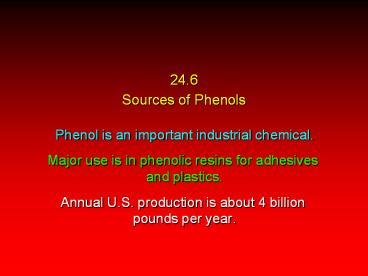24.6 Sources of Phenols - PowerPoint PPT Presentation
Title:
24.6 Sources of Phenols
Description:
Friedel-Crafts Alkylation (63%) (CH3)3COH reacts with H3PO4 to give ... under Friedel-Crafts conditions, acylation of the ring occurs (C-acylation) O-Acylation ... – PowerPoint PPT presentation
Number of Views:194
Avg rating:3.0/5.0
Title: 24.6 Sources of Phenols
1
24.6Sources of Phenols
- Phenol is an important industrial chemical.
- Major use is in phenolic resins for adhesives
and plastics. - Annual U.S. production is about 4 billion pounds
per year.
2
IndustrialPreparationsof Phenol
1. NaOH heat
2. H
1. O2
1. NaOH heat
2. H2O H2SO4
2. H
3
Laboratory Synthesis of Phenols
- from arylamines via diazonium ions
(81-86)
4
24.7Naturally Occurring Phenols
- Many phenols occur naturally
5
Example Thymol
OH
CH3
CH(CH3)2
Thymol(major constituent of oil of thyme)
6
Example 2,5-Dichlorophenol
OH
Cl
Cl
2,5-Dichlorophenol(from defensive secretion ofa
species of grasshopper)
7
24.8Reactions of PhenolsElectrophilic Aromatic
Substitution
Hydroxyl group strongly activates the ringtoward
electrophilic aromatic substitution
8
Electrophilic Aromatic Substitution in Phenols
- Halogenation
- Nitration
- Nitrosation
- Sulfonation
- Friedel-Crafts Alkylation
- Friedel-Crafts Acylation
9
Halogenation
Br2
(93)
- monohalogenation in nonpolar solvent(1,2-dichloro
ethane)
10
Halogenation
H2O
3Br2
25C
(95)
- multiple halogenation in polar solvent(water)
11
Electrophilic Aromatic Substitution in Phenols
- Halogenation
- Nitration
- Nitrosation
- Sulfonation
- Friedel-Crafts Alkylation
- Friedel-Crafts Acylation
12
Nitration
(73-77)
- OH group controls regiochemistry
13
Electrophilic Aromatic Substitution in Phenols
- Halogenation
- Nitration
- Nitrosation
- Sulfonation
- Friedel-Crafts Alkylation
- Friedel-Crafts Acylation
14
Nitrosation
NO
OH
(99)
- only strongly activated rings undergo
nitrosation when treated with nitrous acid
15
Electrophilic Aromatic Substitution in Phenols
- Halogenation
- Nitration
- Nitrosation
- Sulfonation
- Friedel-Crafts Alkylation
- Friedel-Crafts Acylation
16
Sulfonation
H2SO4
100C
SO3H
- OH group controls regiochemistry
(69)
17
Electrophilic Aromatic Substitution in Phenols
- Halogenation
- Nitration
- Nitrosation
- Sulfonation
- Friedel-Crafts Alkylation
- Friedel-Crafts Acylation
18
Friedel-Crafts Alkylation
- (CH3)3COH reacts with H3PO4 to give (CH3)3C
(63)
19
Electrophilic Aromatic Substitution in Phenols
- Halogenation
- Nitration
- Nitrosation
- Sulfonation
- Friedel-Crafts Alkylation
- Friedel-Crafts Acylation
20
24.9Acylation of Phenols
Acylation can take place either on the ringby
electrophilic aromatic substitution or onoxygen
by nucleophilic acyl substitution
21
Friedel-Crafts Acylation
ortho isomer
AlCl3
- under Friedel-Crafts conditions, acylation of the
ring occurs(C-acylation)
(74)
(16)
22
O-Acylation
(95)
- in the absence of AlCl3, acylation of the
hydroxyl group occurs (O-acylation)
23
O- versus C-Acylation
AlCl3
formed faster
more stable
- O-Acylation is kinetically controlled process
C-acylation is thermodynamically controlled - AlCl3 catalyzes the conversion of the aryl ester
to the aryl alkyl ketones this is called the
Fries rearrangement
24
24.10Carboxylation of Phenols
- Aspirin and the Kolbe-Schmitt Reaction
25
Aspirin is prepared from salicylic acid
H2SO4
- how is salicylic acid prepared?
26
Preparation of Salicylic Acid
CO2
125C, 100 atm
- called the Kolbe-Schmitt reaction
- acidification converts the sodium salt
shownabove to salicylic acid
27
What Drives the Reaction?
- acid-base considerations provide an
explanationstronger base on left weaker base
on right
CO2
stronger base pKa of conjugate acid 10
weaker base pKa of conjugate acid 3
28
Preparation of Salicylic Acid
CO2
125C, 100 atm
- how does carbon-carbon bond form?
- recall electron delocalization in phenoxide ion
- negative charge shared by oxygen and by
the ring carbons that are ortho and para to
oxygen
29
(No Transcript)
30
Mechanism of ortho Carboxylation
C
O
O
H
31
Mechanism of ortho Carboxylation
O
C
O
O
O
H
H
32
Why ortho?Why not para?
33
Why ortho?Why not para?
stronger base pKa of conjugate acid 4.5
weaker base pKa of conjugate acid 3
34
Intramolecular Hydrogen Bondingin Salicylate Ion
Hydrogen bonding between carboxylate and
hydroxylgroup stabilizes salicylate ion.
Salicylate is less basic than para isomer and
predominates under conditionsof thermodynamic
control.































